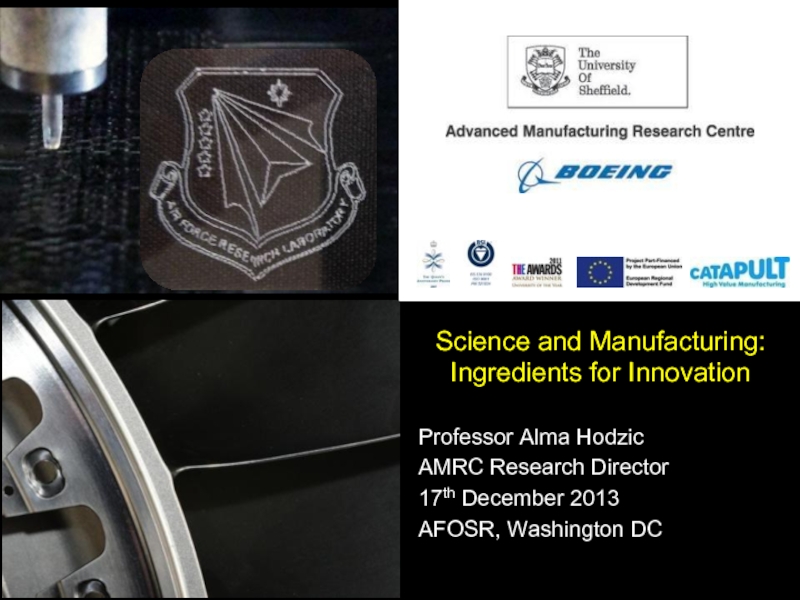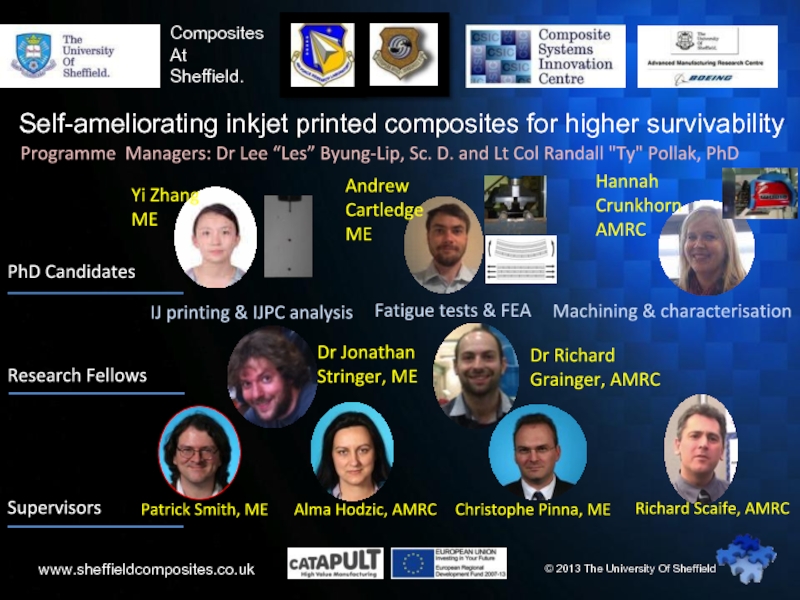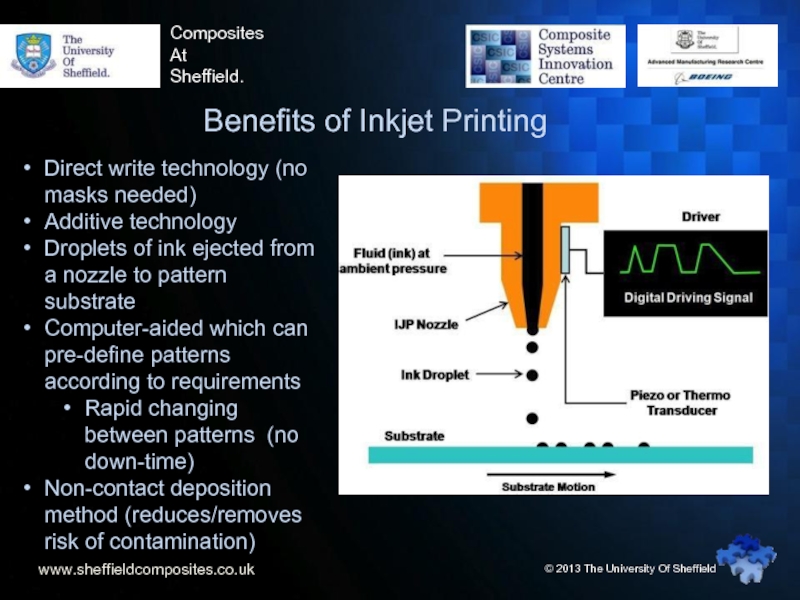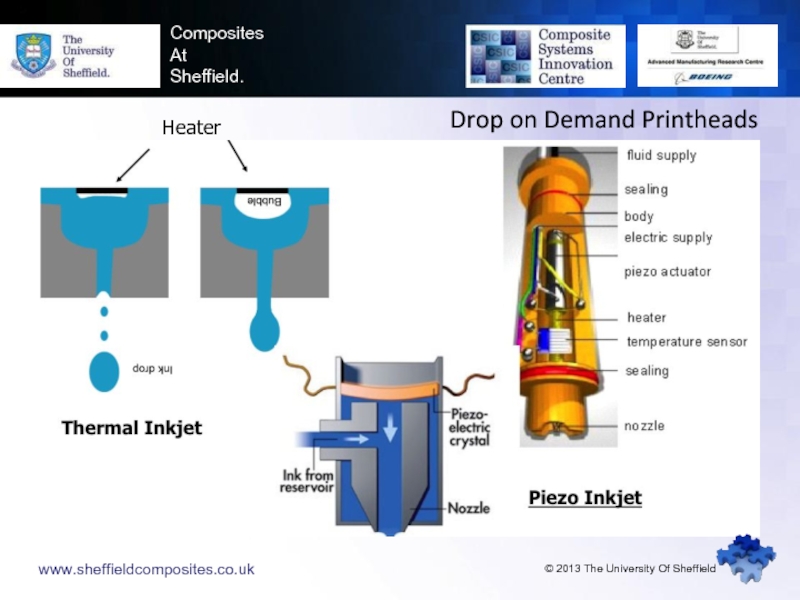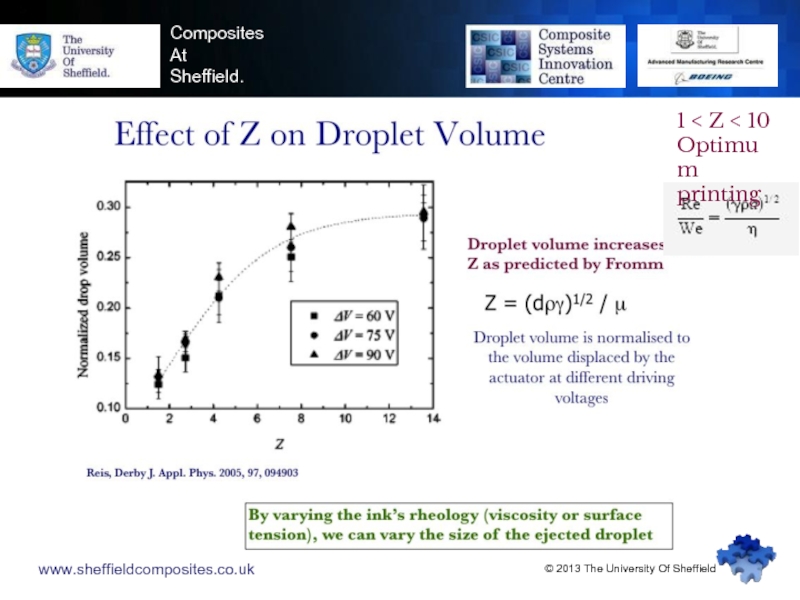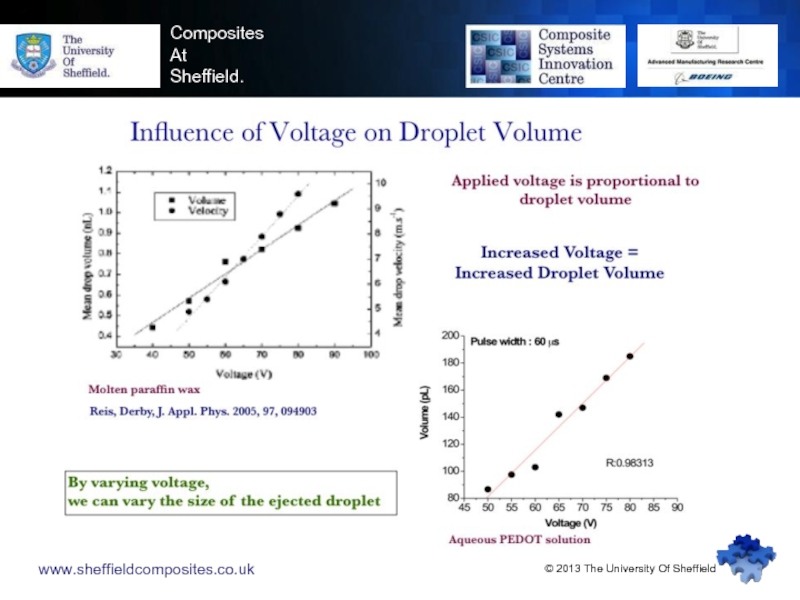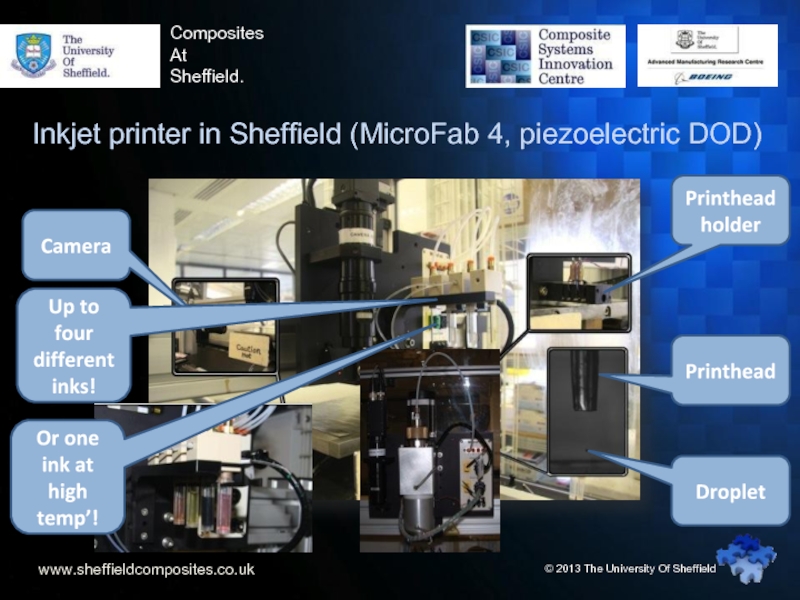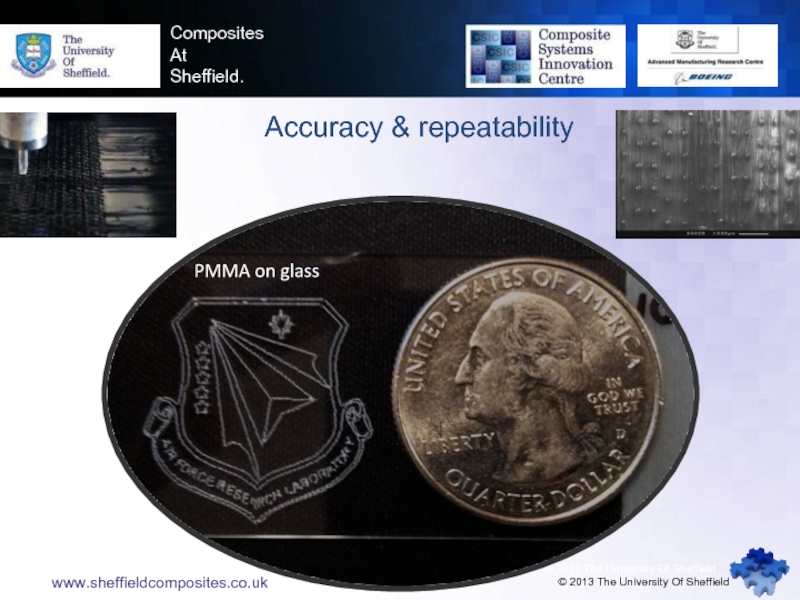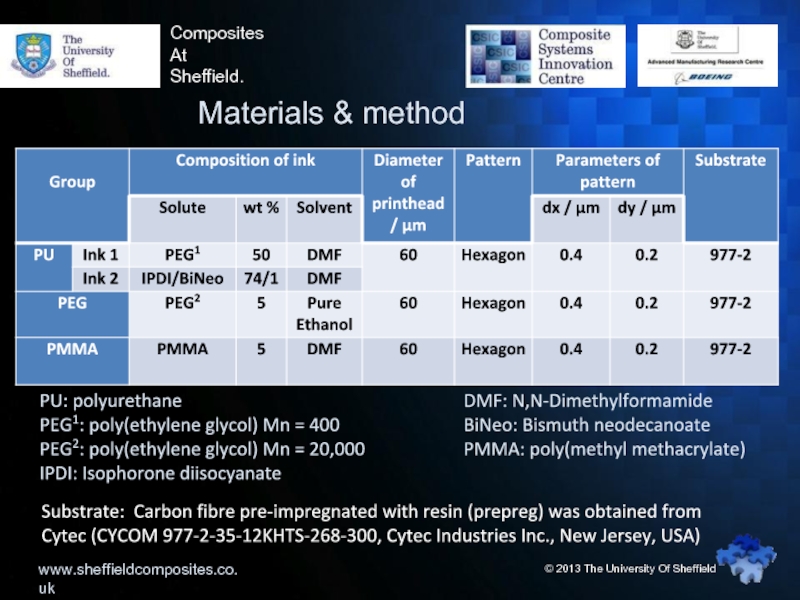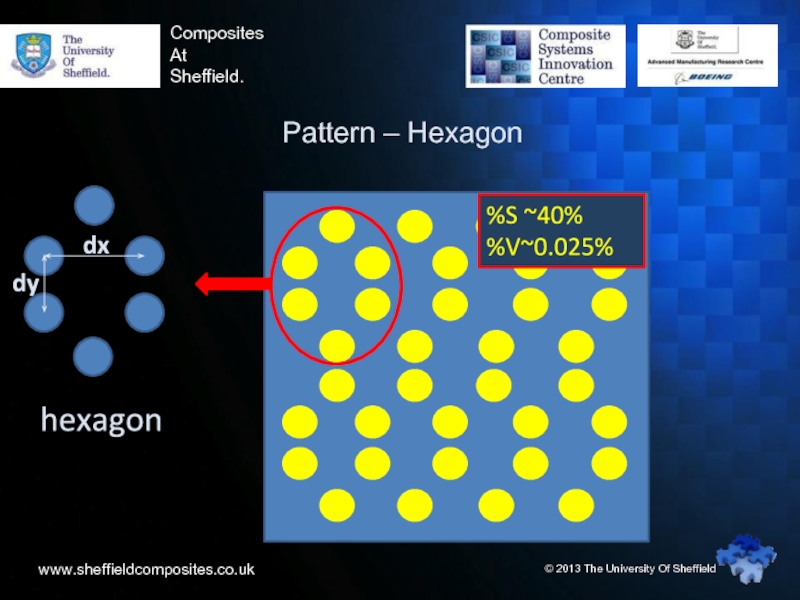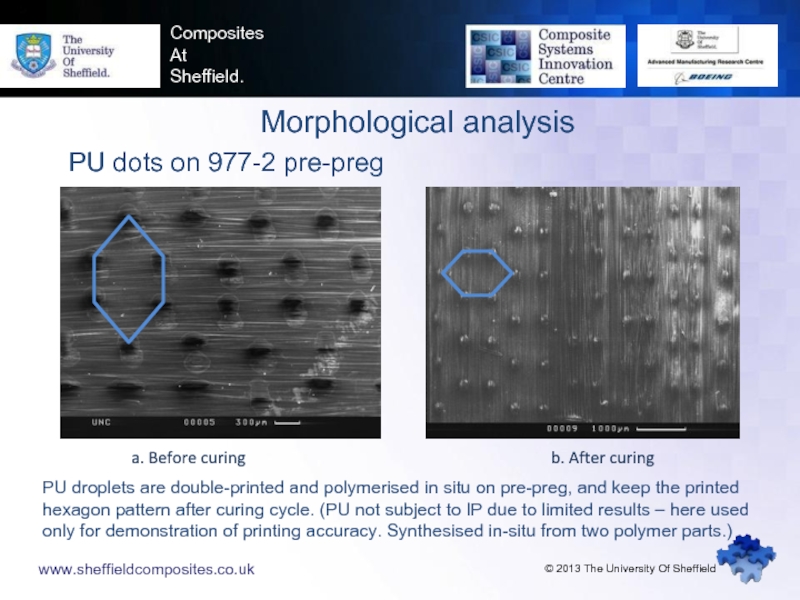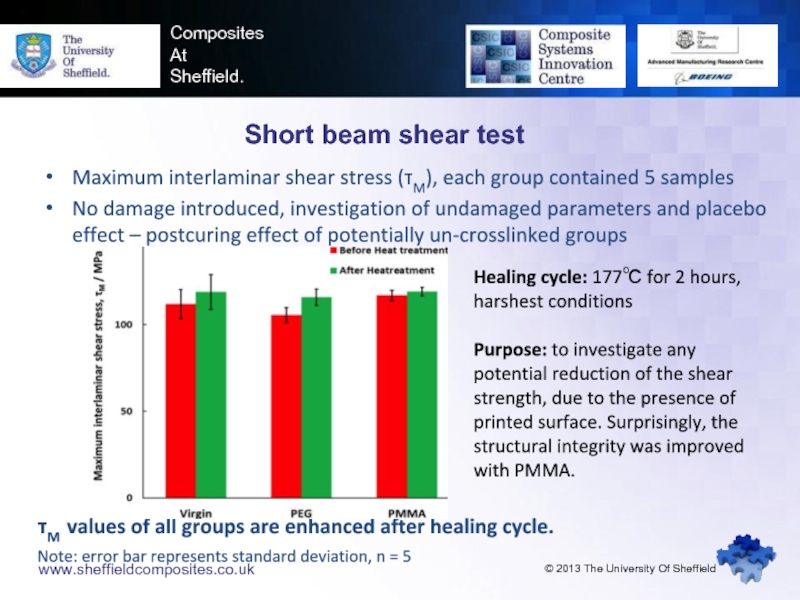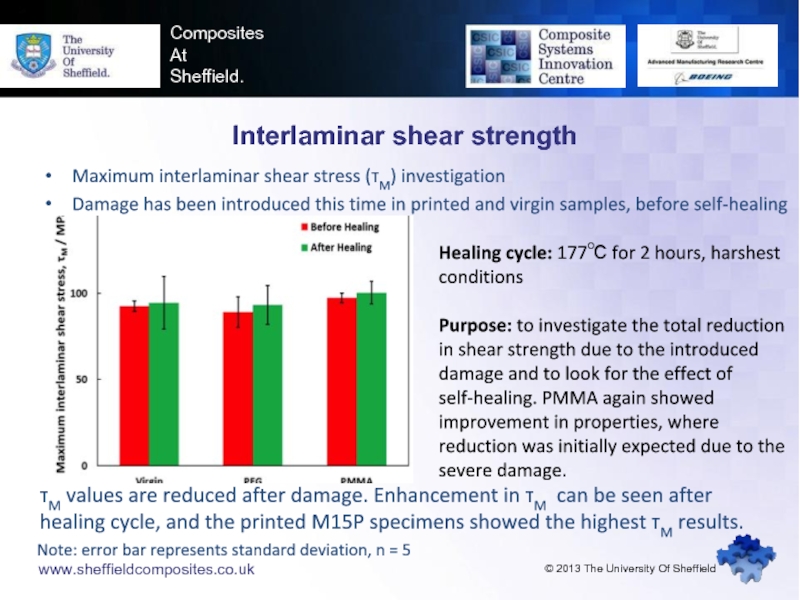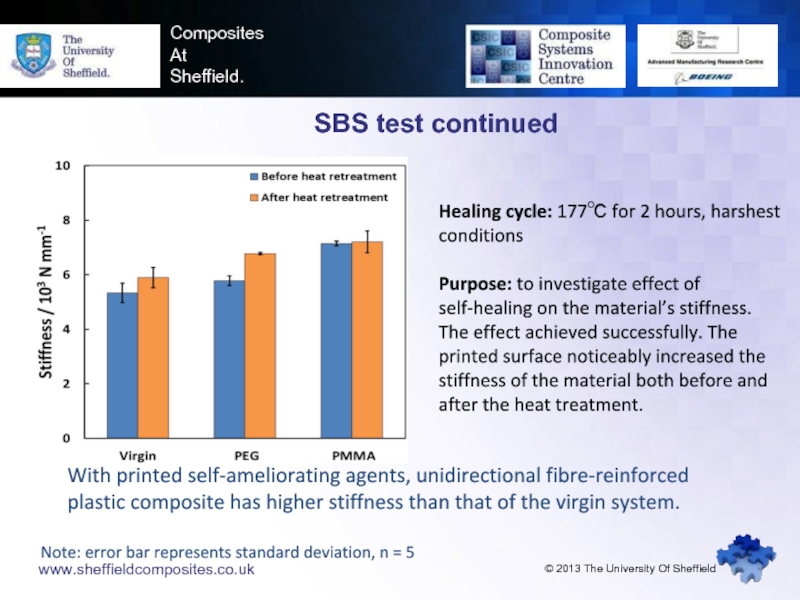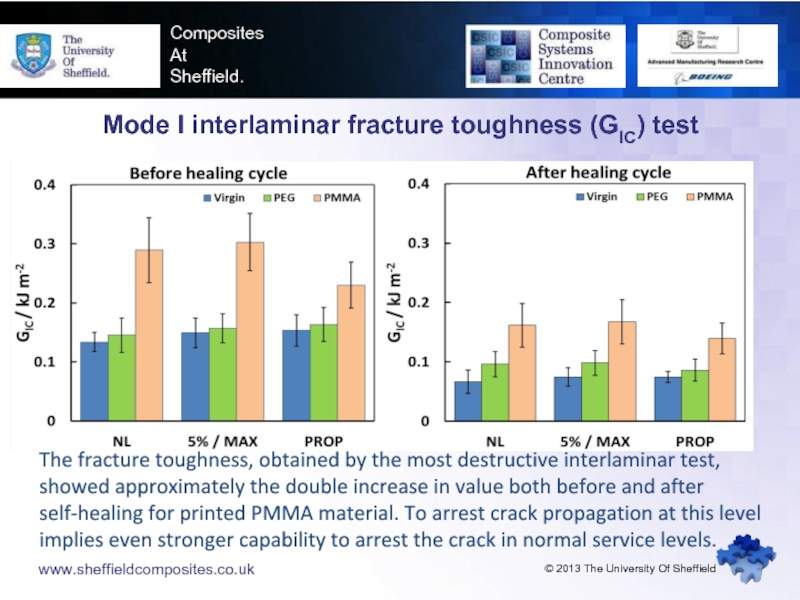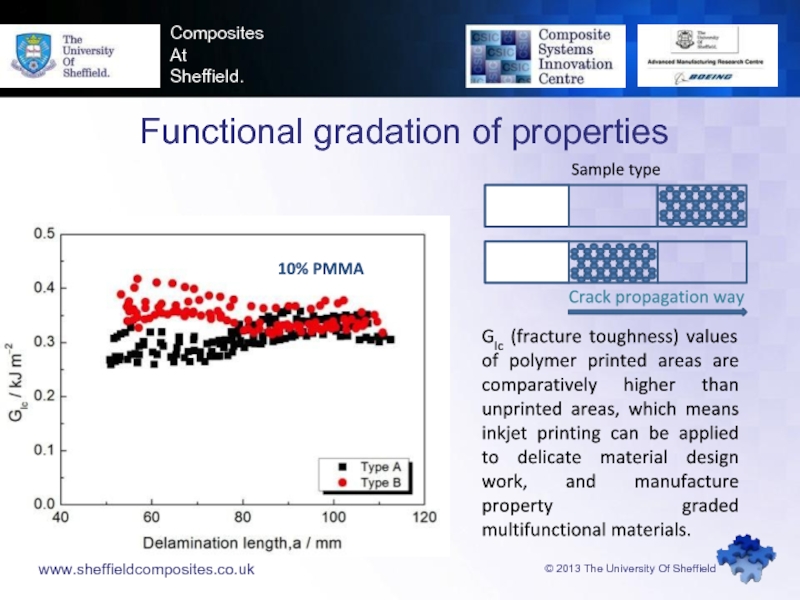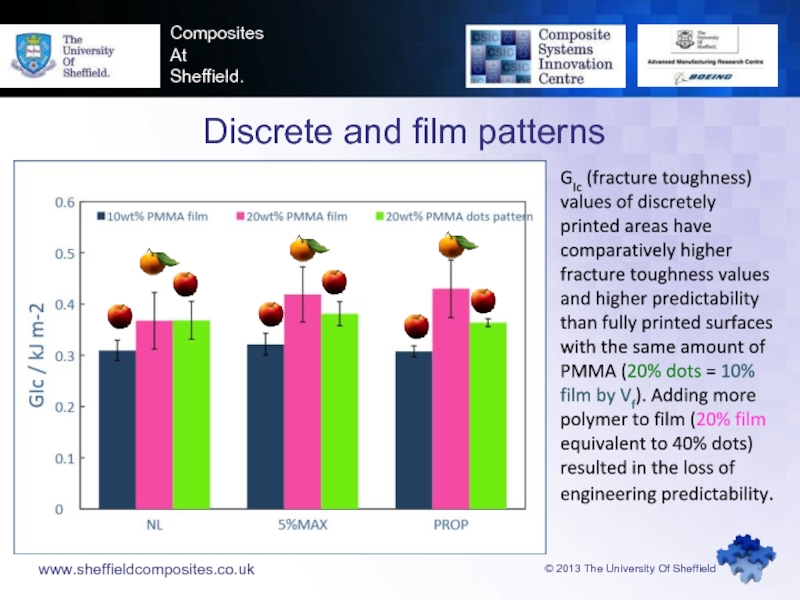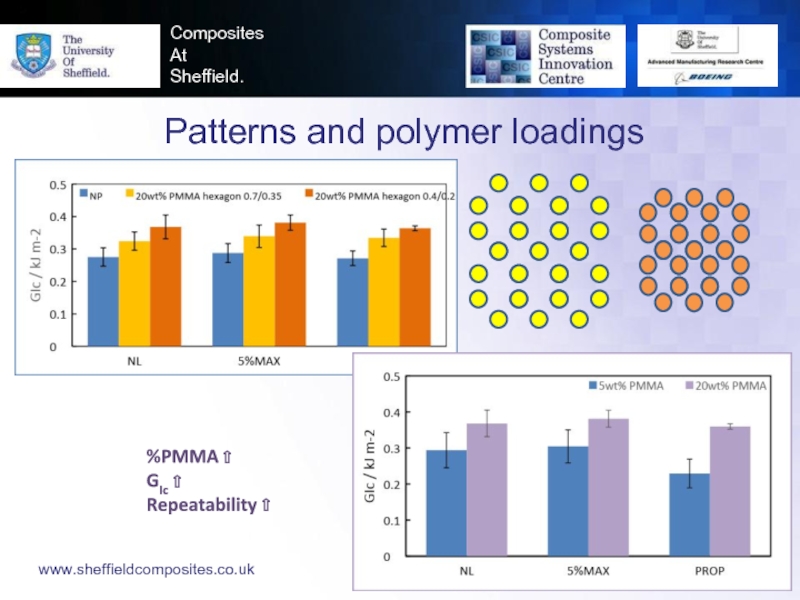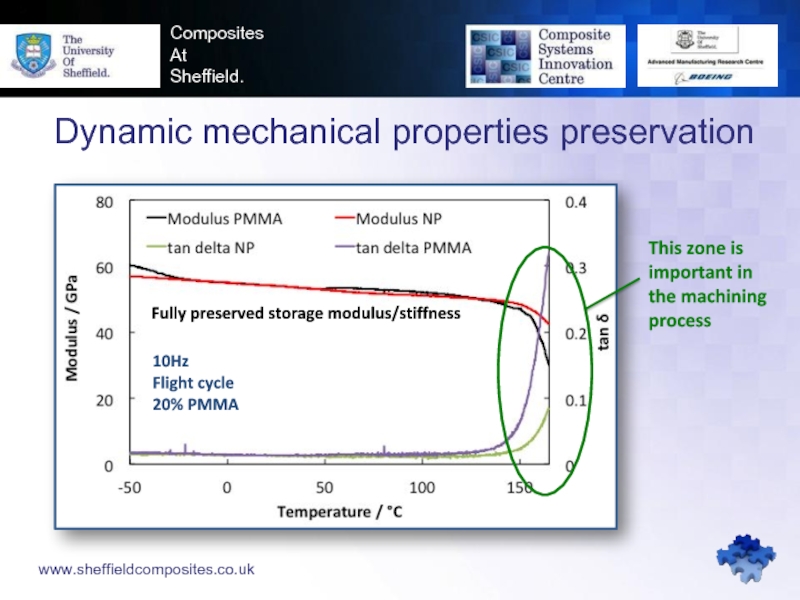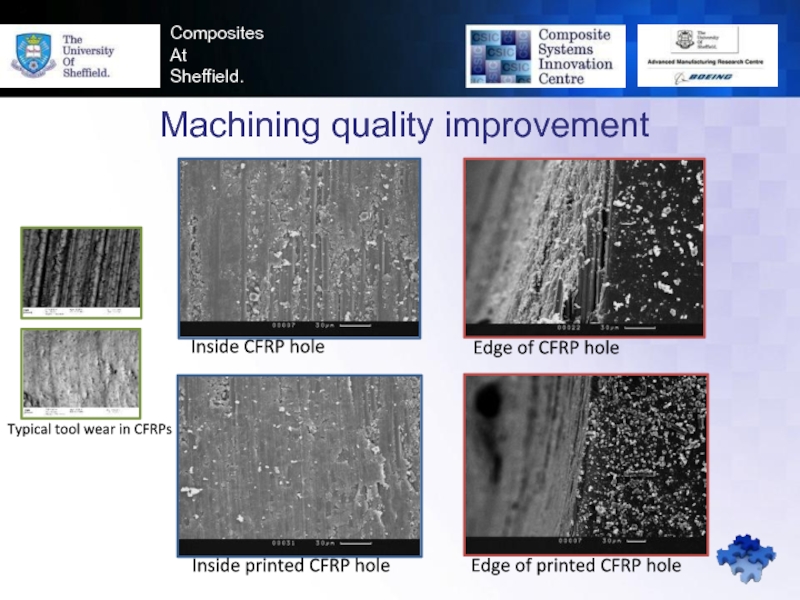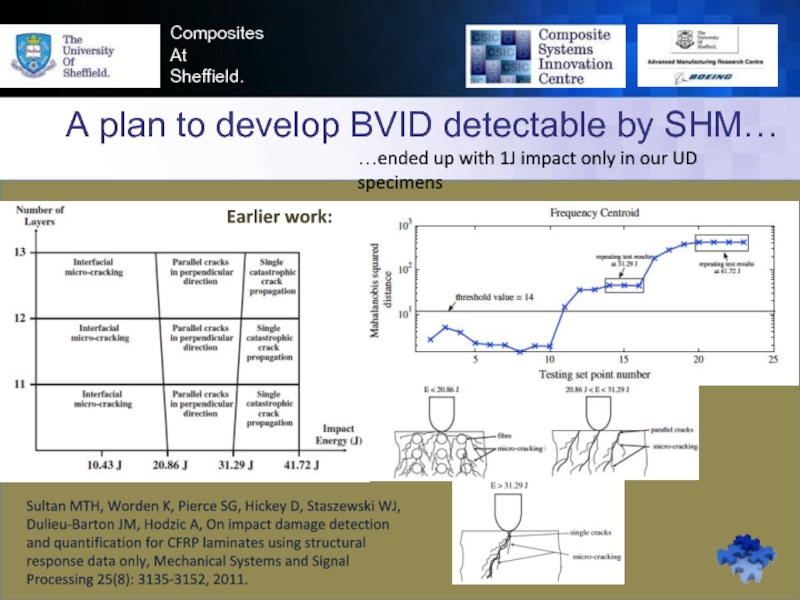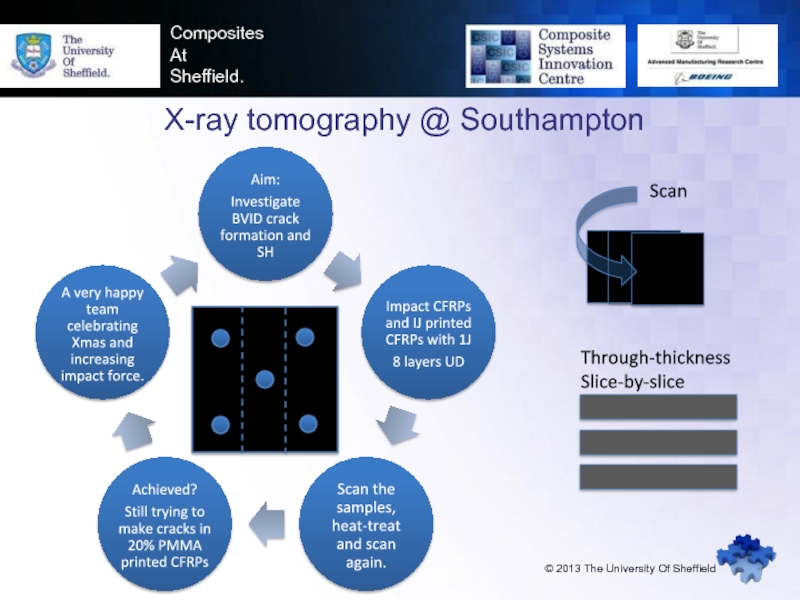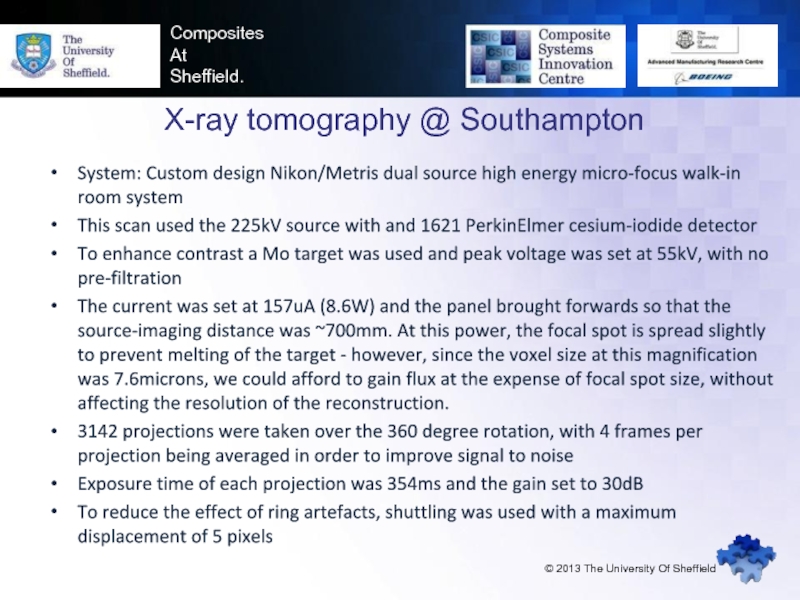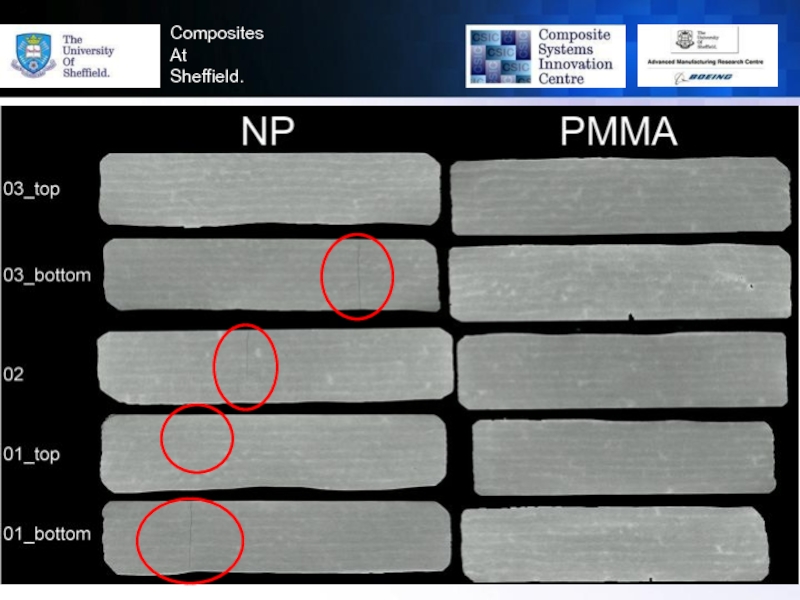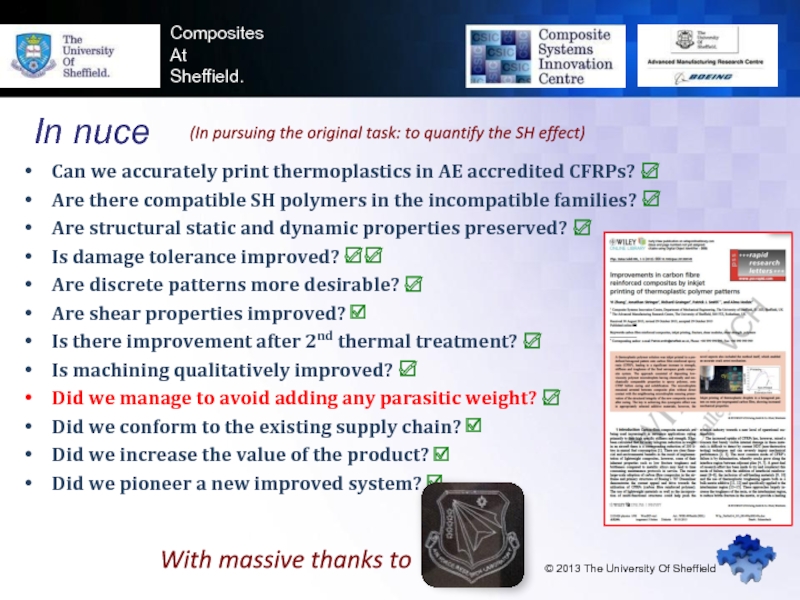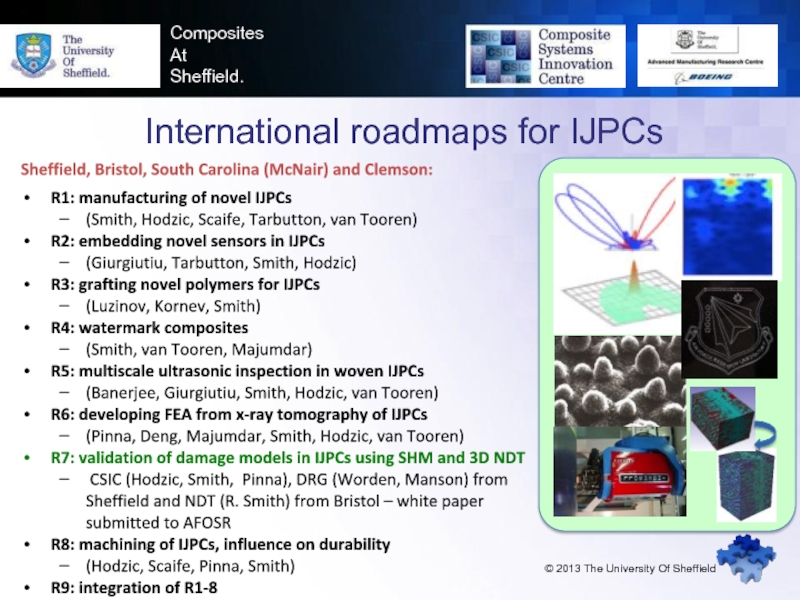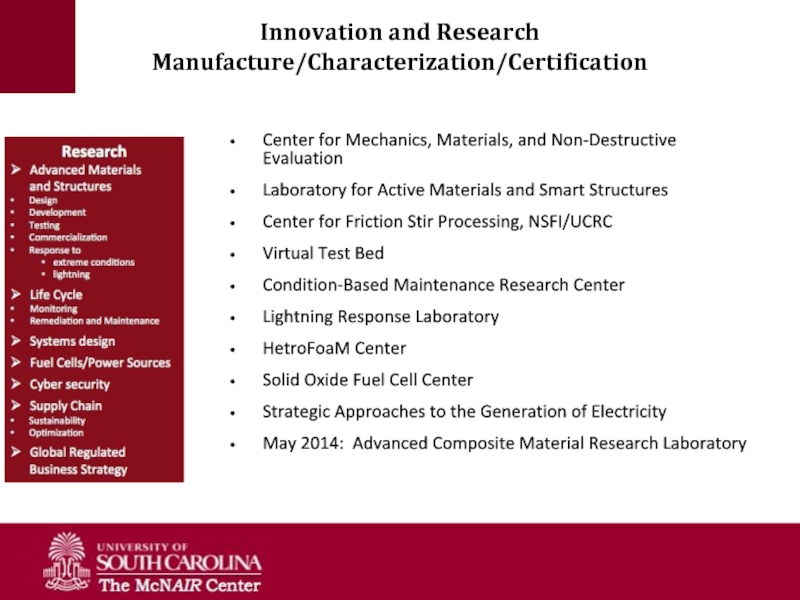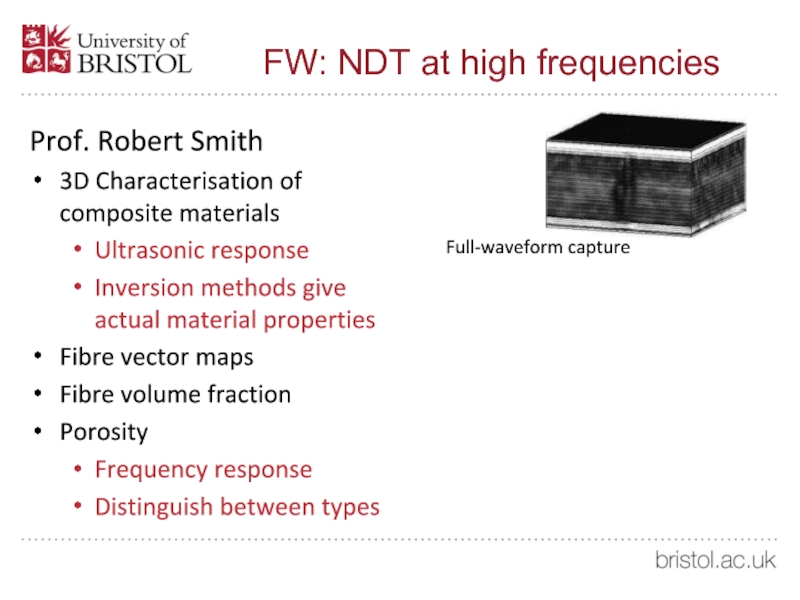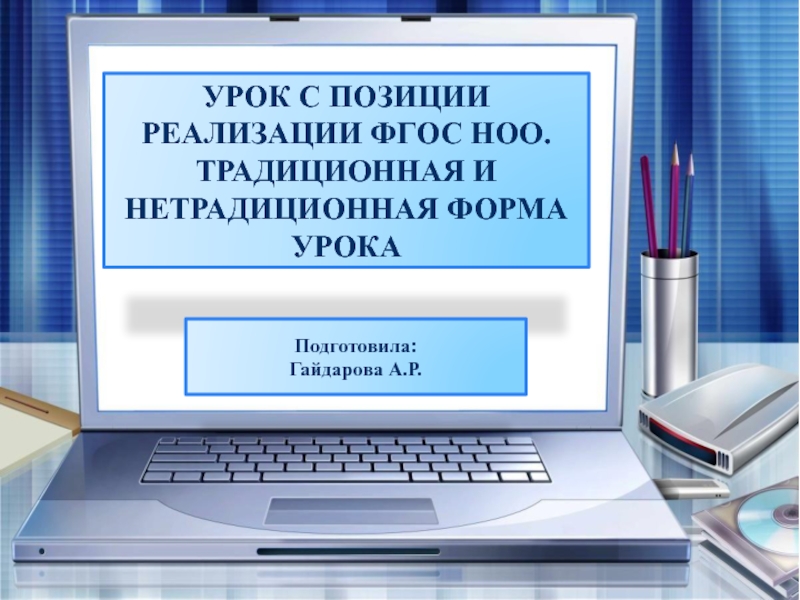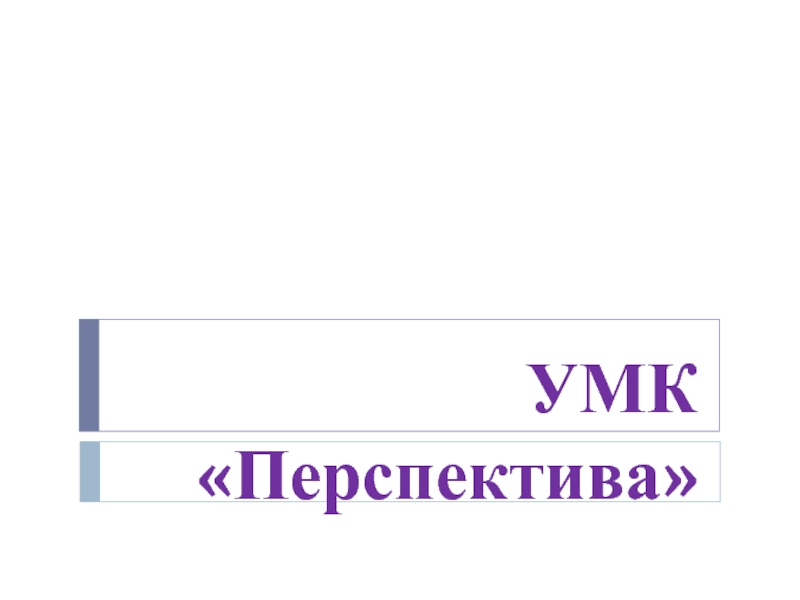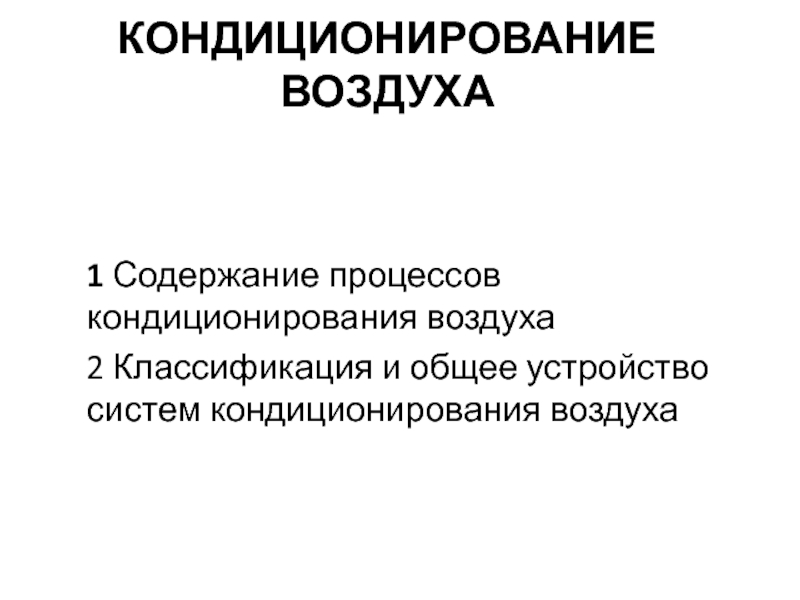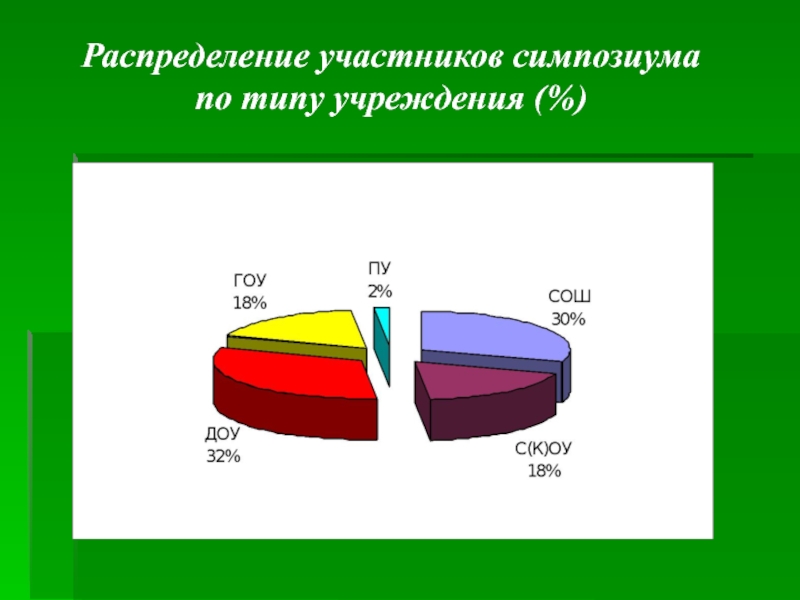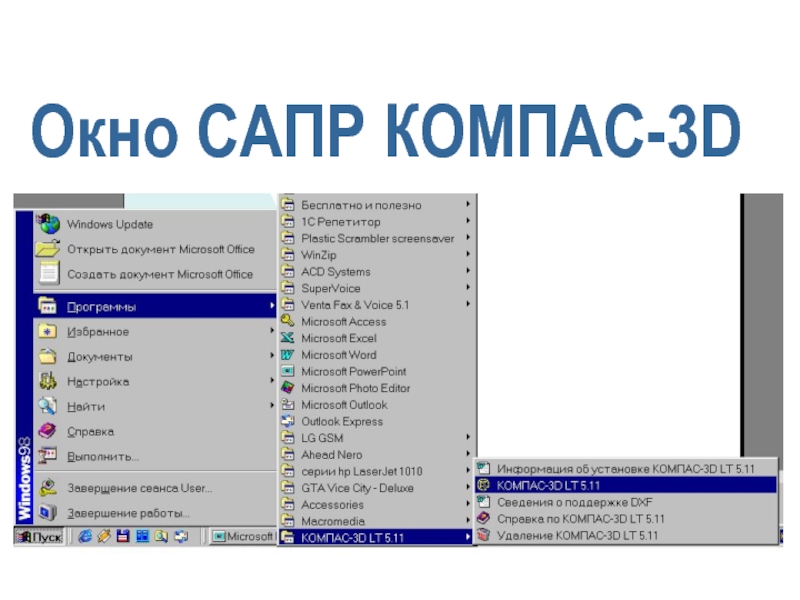- Главная
- Разное
- Дизайн
- Бизнес и предпринимательство
- Аналитика
- Образование
- Развлечения
- Красота и здоровье
- Финансы
- Государство
- Путешествия
- Спорт
- Недвижимость
- Армия
- Графика
- Культурология
- Еда и кулинария
- Лингвистика
- Английский язык
- Астрономия
- Алгебра
- Биология
- География
- Детские презентации
- Информатика
- История
- Литература
- Маркетинг
- Математика
- Медицина
- Менеджмент
- Музыка
- МХК
- Немецкий язык
- ОБЖ
- Обществознание
- Окружающий мир
- Педагогика
- Русский язык
- Технология
- Физика
- Философия
- Химия
- Шаблоны, картинки для презентаций
- Экология
- Экономика
- Юриспруденция
Self-ameliorating inkjet printed composites презентация
Содержание
- 1. Self-ameliorating inkjet printed composites
- 2. Self-ameliorating inkjet printed composites for
- 3. www.sheffieldcomposites.co.uk Composites At Sheffield. Benefits
- 4. www.sheffieldcomposites.co.uk Composites At Sheffield. Drop
- 5. www.sheffieldcomposites.co.uk Composites At Sheffield. ©
- 6. www.sheffieldcomposites.co.uk Composites At Sheffield. © 2013 The University Of Sheffield
- 7. www.sheffieldcomposites.co.uk Composites At Sheffield. Inkjet
- 8. www.sheffieldcomposites.co.uk Accuracy & repeatability © 2013 The
- 9. www.sheffieldcomposites.co.uk Composites At Sheffield. Materials
- 10. www.sheffieldcomposites.co.uk Composites At Sheffield. Pattern
- 11. www.sheffieldcomposites.co.uk Composites At Sheffield. Morphological
- 12. www.sheffieldcomposites.co.uk Composites At Sheffield. Short
- 13. www.sheffieldcomposites.co.uk Composites At Sheffield. Interlaminar
- 14. www.sheffieldcomposites.co.uk Composites At Sheffield. SBS
- 15. www.sheffieldcomposites.co.uk Composites At Sheffield. Mode
- 16. www.sheffieldcomposites.co.uk © 2013 The University Of Sheffield
- 17. www.sheffieldcomposites.co.uk © 2013 The University Of Sheffield
- 18. www.sheffieldcomposites.co.uk © 2013 The University Of Sheffield
- 19. www.sheffieldcomposites.co.uk Composites At Sheffield. Dynamic
- 20. Composites At Sheffield. Machining quality
- 21. Composites At Sheffield. A
- 22. Composites At Sheffield. X-ray tomography
- 23. Composites At Sheffield. X-ray tomography
- 24. Composites At Sheffield.
- 25. Composites At Sheffield. In nuce
- 26. Composites At Sheffield. International
- 27. Innovation and Research Manufacture/Characterization/Certification Center for Mechanics,
- 28. FW: NDT at high frequencies Prof. Robert
Слайд 1Science and Manufacturing: Ingredients for Innovation
Professor Alma Hodzic
AMRC Research Director
17th December
AFOSR, Washington DC
Слайд 2
Self-ameliorating inkjet printed composites for higher survivability
www.sheffieldcomposites.co.uk
Composites
At
Sheffield.
© 2013 The
Yi Zhang
ME
Patrick Smith, ME
Andrew Cartledge
ME
Hannah Crunkhorn
AMRC
Dr Jonathan Stringer, ME
Dr Richard Grainger, AMRC
Alma Hodzic, AMRC
Christophe Pinna, ME
Richard Scaife, AMRC
PhD Candidates
Research Fellows
Supervisors
Programme Managers: Dr Lee “Les” Byung-Lip, Sc. D. and Lt Col Randall "Ty" Pollak, PhD
Fatigue tests & FEA
IJ printing & IJPC analysis
Machining & characterisation
Слайд 3www.sheffieldcomposites.co.uk
Composites
At
Sheffield.
Benefits of Inkjet Printing
Direct write technology (no masks
Additive technology
Droplets of ink ejected from a nozzle to pattern substrate
Computer-aided which can pre-define patterns according to requirements
Rapid changing between patterns (no down-time)
Non-contact deposition method (reduces/removes risk of contamination)
© 2013 The University Of Sheffield
Слайд 4www.sheffieldcomposites.co.uk
Composites
At
Sheffield.
Drop on Demand Printheads
Heater
© 2013 The University Of Sheffield
Слайд 5www.sheffieldcomposites.co.uk
Composites
At
Sheffield.
© 2013 The University Of Sheffield
1 < Z
Optimum
printing
Слайд 7www.sheffieldcomposites.co.uk
Composites
At
Sheffield.
Inkjet printer in Sheffield (MicroFab 4, piezoelectric DOD)
Up to
Or one ink at high temp’!
© 2013 The University Of Sheffield
Слайд 8www.sheffieldcomposites.co.uk
Accuracy & repeatability
© 2013 The University Of Sheffield
Composites
At
Sheffield.
www.sheffieldcomposites.co.uk
© 2013
Слайд 9www.sheffieldcomposites.co.uk
Composites
At
Sheffield.
Materials & method
© 2013 The University Of Sheffield
PU: polyurethane
PEG1:
PEG2: poly(ethylene glycol) Mn = 20,000
IPDI: Isophorone diisocyanate
DMF: N,N-Dimethylformamide
BiNeo: Bismuth neodecanoate
PMMA: poly(methyl methacrylate)
Substrate: Carbon fibre pre-impregnated with resin (prepreg) was obtained from Cytec (CYCOM 977-2-35-12KHTS-268-300, Cytec Industries Inc., New Jersey, USA)
Слайд 10www.sheffieldcomposites.co.uk
Composites
At
Sheffield.
Pattern – Hexagon
hexagon
© 2013 The University Of Sheffield
%S
%V~0.025%
Слайд 11www.sheffieldcomposites.co.uk
Composites
At
Sheffield.
Morphological analysis
PU dots on 977-2 pre-preg
a. Before curing
PU droplets are double-printed and polymerised in situ on pre-preg, and keep the printed hexagon pattern after curing cycle. (PU not subject to IP due to limited results – here used only for demonstration of printing accuracy. Synthesised in-situ from two polymer parts.)
© 2013 The University Of Sheffield
Слайд 12www.sheffieldcomposites.co.uk
Composites
At
Sheffield.
Short beam shear test
Maximum interlaminar shear stress (τM), each
No damage introduced, investigation of undamaged parameters and placebo effect – postcuring effect of potentially un-crosslinked groups
τM values of all groups are enhanced after healing cycle.
Healing cycle: 177℃ for 2 hours, harshest conditions
Purpose: to investigate any potential reduction of the shear strength, due to the presence of printed surface. Surprisingly, the structural integrity was improved with PMMA.
© 2013 The University Of Sheffield
Note: error bar represents standard deviation, n = 5
Слайд 13www.sheffieldcomposites.co.uk
Composites
At
Sheffield.
Interlaminar shear strength
Maximum interlaminar shear stress (τM) investigation
Damage has
Note: error bar represents standard deviation, n = 5
τM values are reduced after damage. Enhancement in τM can be seen after healing cycle, and the printed M15P specimens showed the highest τM results.
© 2013 The University Of Sheffield
Healing cycle: 177℃ for 2 hours, harshest conditions
Purpose: to investigate the total reduction in shear strength due to the introduced damage and to look for the effect of self-healing. PMMA again showed improvement in properties, where reduction was initially expected due to the severe damage.
Слайд 14www.sheffieldcomposites.co.uk
Composites
At
Sheffield.
SBS test continued
With printed self-ameliorating agents, unidirectional fibre-reinforced plastic
© 2013 The University Of Sheffield
Healing cycle: 177℃ for 2 hours, harshest conditions
Purpose: to investigate effect of self-healing on the material’s stiffness.
The effect achieved successfully. The printed surface noticeably increased the stiffness of the material both before and after the heat treatment.
Note: error bar represents standard deviation, n = 5
Слайд 15www.sheffieldcomposites.co.uk
Composites
At
Sheffield.
Mode I interlaminar fracture toughness (GIC) test
The fracture toughness,
© 2013 The University Of Sheffield
Слайд 16www.sheffieldcomposites.co.uk
© 2013 The University Of Sheffield
Composites
At
Sheffield.
GIc (fracture toughness) values
Functional gradation of properties
Crack propagation way
10% PMMA
Слайд 17www.sheffieldcomposites.co.uk
© 2013 The University Of Sheffield
Composites
At
Sheffield.
GIc (fracture toughness) values
Discrete and film patterns
Слайд 18www.sheffieldcomposites.co.uk
© 2013 The University Of Sheffield
Composites
At
Sheffield.
Patterns and polymer loadings
%PMMA
GIc ⇧
Repeatability ⇧
Слайд 19www.sheffieldcomposites.co.uk
Composites
At
Sheffield.
Dynamic mechanical properties preservation
10Hz
Flight cycle
20% PMMA
This zone is
important
the machining
process
Fully preserved storage modulus/stiffness
Слайд 20Composites
At
Sheffield.
Machining quality improvement
Inside CFRP hole
Edge of CFRP hole
Inside printed
Edge of printed CFRP hole
Typical tool wear in CFRPs
Слайд 21
Composites
At
Sheffield.
A plan to develop BVID detectable by SHM…
Sultan MTH,
Earlier work:
…ended up with 1J impact only in our UD specimens
Слайд 22Composites
At
Sheffield.
X-ray tomography @ Southampton
© 2013 The University Of Sheffield
Scan
Through-thickness
Slice-by-slice
Слайд 23Composites
At
Sheffield.
X-ray tomography @ Southampton
© 2013 The University Of Sheffield
System:
This scan used the 225kV source with and 1621 PerkinElmer cesium-iodide detector
To enhance contrast a Mo target was used and peak voltage was set at 55kV, with no pre-filtration
The current was set at 157uA (8.6W) and the panel brought forwards so that the source-imaging distance was ~700mm. At this power, the focal spot is spread slightly to prevent melting of the target - however, since the voxel size at this magnification was 7.6microns, we could afford to gain flux at the expense of focal spot size, without affecting the resolution of the reconstruction.
3142 projections were taken over the 360 degree rotation, with 4 frames per projection being averaged in order to improve signal to noise
Exposure time of each projection was 354ms and the gain set to 30dB
To reduce the effect of ring artefacts, shuttling was used with a maximum displacement of 5 pixels
Слайд 25Composites
At
Sheffield.
In nuce
© 2013 The University Of Sheffield
Can we accurately
Are there compatible SH polymers in the incompatible families? ☑
Are structural static and dynamic properties preserved? ☑
Is damage tolerance improved? ☑☑
Are discrete patterns more desirable? ☑
Are shear properties improved? ☑
Is there improvement after 2nd thermal treatment? ☑
Is machining qualitatively improved? ☑
Did we manage to avoid adding any parasitic weight? ☑
Did we conform to the existing supply chain? ☑
Did we increase the value of the product? ☑
Did we pioneer a new improved system? ☑
(In pursuing the original task: to quantify the SH effect)
With massive thanks to
Слайд 26
Composites
At
Sheffield.
International roadmaps for IJPCs
© 2013 The University Of Sheffield
Sheffield,
R1: manufacturing of novel IJPCs
(Smith, Hodzic, Scaife, Tarbutton, van Tooren)
R2: embedding novel sensors in IJPCs
(Giurgiutiu, Tarbutton, Smith, Hodzic)
R3: grafting novel polymers for IJPCs
(Luzinov, Kornev, Smith)
R4: watermark composites
(Smith, van Tooren, Majumdar)
R5: multiscale ultrasonic inspection in woven IJPCs
(Banerjee, Giurgiutiu, Smith, Hodzic, van Tooren)
R6: developing FEA from x-ray tomography of IJPCs
(Pinna, Deng, Majumdar, Smith, Hodzic, van Tooren)
R7: validation of damage models in IJPCs using SHM and 3D NDT
CSIC (Hodzic, Smith, Pinna), DRG (Worden, Manson) from Sheffield and NDT (R. Smith) from Bristol – white paper submitted to AFOSR
R8: machining of IJPCs, influence on durability
(Hodzic, Scaife, Pinna, Smith)
R9: integration of R1-8
Слайд 27Innovation and Research Manufacture/Characterization/Certification
Center for Mechanics, Materials, and Non-Destructive Evaluation
Laboratory for
Center for Friction Stir Processing, NSFI/UCRC
Virtual Test Bed
Condition-Based Maintenance Research Center
Lightning Response Laboratory
HetroFoaM Center
Solid Oxide Fuel Cell Center
Strategic Approaches to the Generation of Electricity
May 2014: Advanced Composite Material Research Laboratory
Слайд 28FW: NDT at high frequencies
Prof. Robert Smith
3D Characterisation of composite materials
Ultrasonic response
Inversion methods give actual material properties
Fibre vector maps
Fibre volume fraction
Porosity
Frequency response
Distinguish between types
Full-waveform capture
In-plane slice
Out-of-plane slice
Wrinkle
Vector Map
Porosity
